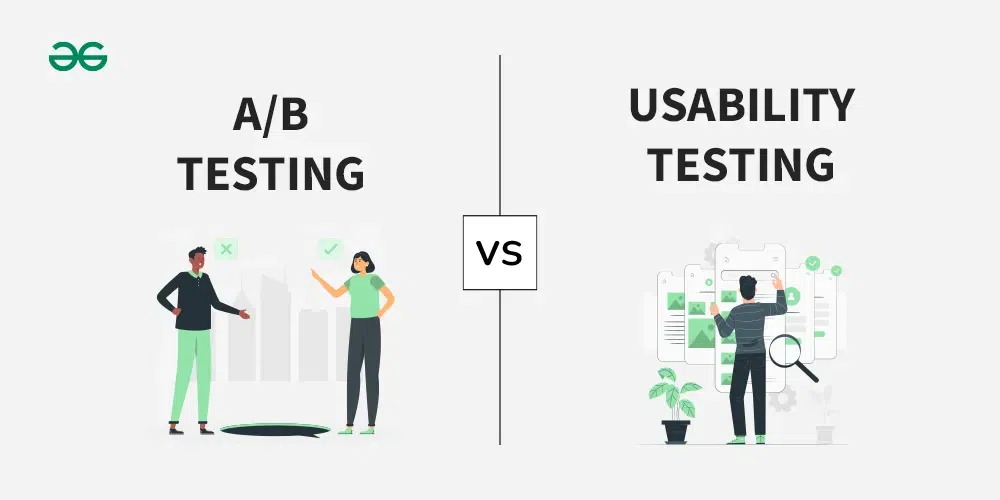Difference Between A/B Testing and Usability Testing in Product Mangement
Last Updated :
02 Feb, 2024
Conversion rates rise when usability and A/B testing in product management are combined to produce better customer-focused experiences. They work well together, despite common beliefs about which choice produces the best outcomes. Using both has advantages and disadvantages, but it also reveals human understanding to improve your design. We’ll go into further detail on A/B testing and usability. Testing for usability should come first.

A/B Testing and Usability Testing
Product managers utilize A/B testing, sometimes referred to as split testing, as a scientific method to evaluate two or more iterations of a variable and determine which one works better. These factors may be a feature’s layout, a button’s design, or even a whole marketing campaign. The objective is to collect data-driven insights so that you may decide which version will appeal to users more and help you get your intended results in the end.
What is Usability Testing?
The process of usability testing involves watching people’s interactions and reactions to your product. These days, remote, unmoderated tests prearranged and completed by your ideal user can be included in usability testing. You can obtain findings with a range of usability testing tools.
Before and after a product launch, usability testing rapidly identifies areas for improvement, from preference testing to identifying places where users become lost and confused.
A/B Testing Vs Usability Testing:
| Optimize specific features based on metrics. |
Identify and improve overall user experience. |
| Data-driven decisions on specific elements. |
Qualitative insights for holistic improvements. |
| Used in iterative cycles for feature optimization. |
Valuable throughout the product development lifecycle. |
| Focus on specific metrics and elements. |
Broad understanding of user interactions. |
| Reduces risk with incremental changes. |
Identifies and addresses issues before full launch. |
| Quantitative data for optimization. |
Qualitative insights for user experience. |
| After implementation for feature comparison. |
Applied at various stages for comprehensive insights. |
| Provides quick feedback for rapid iteration. |
May take longer for in-depth observations and analysis. |
Conclusion: A/B Testing and Usability Testing
Selecting the right time to do usability testing and A/B testing is crucial. The best approach is to employ both strategies interchangeably because they achieve different aims. While A/B testing explains user preferences and which feature works best on your site, usability testing explains user behaviors and the reasons behind their decisions.
A/B testing clarifies the numeric data, whereas usability testing yields qualitative information. Use both options for best outcomes. Usability testing is a useful tool when trying to understand your user better. Use A/B testing to learn how to optimize your website for higher conversion rates. Human insights are realized at the nexus of quantitative and qualitative data techniques. Both approaches have their uses, but when combined, they allow you to see things you may have missed.
FAQs on A/B Testing and Usability Testing:
What is Usability vs Beta testing?
Beta testing is a useful but frequently underappreciated research tool. This is due to the fact that it allows you to observe how your users truly engage with your product, going beyond usability testing. It also demonstrates to you how your users don’t interact with it, which is possibly more significant.
A/B testing, also called split testing, is a type of randomized experimentation in which two or more iterations of a variable (web page, page element, etc.) are simultaneously shown to various website visitor segments in order to ascertain which version has the greatest influence and influences business metrics.
What is the difference between user testing and usability testing?
Usability testing is far more concerned with assessing the functionality and usability of the product itself, whereas user testing is largely focused on understanding users’ wants, issues, and how your product appeals to them.
What are the three types of usability tests?
The three overall usability testing types include:
- Moderated vs. unmoderated.
- Remote vs. in person.
- Explorative vs. comparative.
What type of testing is usability testing?
User research is a subcategory of usability testing. For the purpose of best determining the needs and behavior of a product’s intended customer, user research combines usability testing with techniques such as focus groups, questionnaires, and interviews.
Share your thoughts in the comments
Please Login to comment...